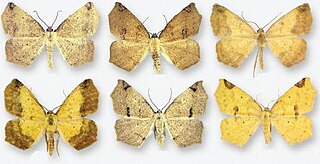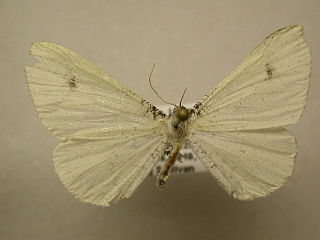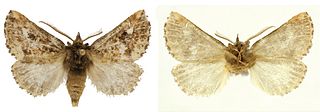
Neotherina is a genus of moths in the family Geometridae erected by Paul Dognin in 1913.

Campatonema tapantia is a moth of the family Geometridae first described by Sullivan in 2010. It is found in the provinces of Alajuela, Cartago and Heredia in Costa Rica. It has been found along a rather narrow elevational range, from 1100 to 1600 meters.

Campatonema lineata is a moth of the family Geometridae first described by William Schaus in 1911. It is found in the provinces of Alajuela, Cartago, Guanacaste, and Puntarenas in Costa Rica, at elevations from 700 to 1500 meters.
Cnissostages mastictor is a species of moth in the family Arrhenophanidae. It is found from Costa Rica to Peru.
Dysoptus spilacris is a species of moth in the family Arrhenophanidae. It is common in both primary and secondary forests in La Selva, Costa Rica. It also has been found in the adjacent Braulio Carrillo National Park and in the Mexican state of Veracruz.

Antepione thisoaria, the variable antepione, is a moth of the family Geometridae. In Canada it is found from Nova Scotia to Manitoba, south into the United States south and west to the Gulf states, as well as Michoacan in Mexico and further south to Costa Rica and Guatemala.
Alasea is a genus of moths in the family Choreutidae, containing only one species, Alasea corniculata, which is known from Costa Rica.

Neotherina imperilla is a species of moth of the family Geometridae first described by Paul Dognin in 1911. It is found in Colombia and Costa Rica.

Sparganocosma is a genus of moths in the family Tortricidae. It contains only one species, Sparganocosma docsturnerorum, which is found in north-western Costa Rica.

Macrosoma albida is moth-like butterfly described by William Schaus in 1901. It belongs to the family Hedylidae. Originally it belonged to the genus Hyphedyle.
Macrosoma amaculata is moth-like butterfly described by Malcolm J. Scoble in 1990. It belongs to the family Hedylidae.
Pseudocomotis nortena is a species of moth of the family Tortricidae. It is found in Costa Rica.
Sparganothoides ocrisana is a species of moth of the family Tortricidae. It is found in Costa Rica, Guatemala and Veracruz in Mexico.
Odonthalitus poas is a species of moth of the family Tortricidae. It is found in Costa Rica.

Phyllodonta esperanza is a moth in the family Geometridae first described by J. Bolling Sullivan in 2014. It is found in the Talamancas and Central Volcanic and Tilarán ranges in Costa Rica, possibly extending into the other Costa Rican mountain ranges and northern Panama. It has been collected at elevations above 1,200 meters.

Phyllodonta intermediata is a moth in the family Geometridae first described by J. Bolling Sullivan in 2014. It is found in the Talamancas and Central Volcanic and Tilarán ranges in Costa Rica, possibly extending into the other Costa Rican mountain ranges and northern Panama. It has been recorded from elevations between 1,275 and 2,280 meters.

Phyllodonta alajuela is a moth in the family Geometridae first described by J. Bolling Sullivan in 2014. It is found in Costa Rica, possibly extending into Nicaragua. It has been recorded from altitudes between 500 and 1,150 meters.

Symmerista minaei is a moth in the family Notodontidae first described by Isidro A. Chacón in 2014. It has been collected at between 2,400 and 2,600 meters in highland cloud forests of the Cordillera de Talamanca in Costa Rica.

Circanota undulata is a species of moth of the family Tortricidae. It is found in Costa Rica and Panama, at altitudes below about 900 meters.

Hagnagora richardi is a species of moth of the family Geometridae first described by Gunnar Brehm in 2015. It is only known from a small region around Podocarpus National Park in Zamora-Chinchipe and Loja provinces in Ecuador.













